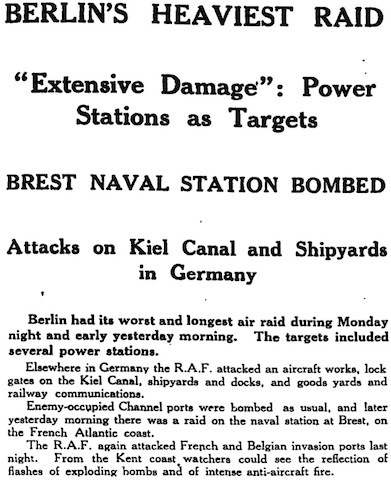
Berlin has had its longest and heaviest raid of the war so far (the lengthening nights would be making it easier for the RAF to get there and back under cover of darkness). The Air Ministry reported the raid as follows (as reported by the Manchester Guardian on page 5):
Throughout last night [Monday] strong bomber forces of the R.A.F. delivered a heavy attack on military objectives in and around Berlin. This attack was on a much larger scale than any yet carried out, and preliminary reports show that extensive damage was done.
Among the targets selected by our aircraft and heavily bombed were Rangsdorf railway station and several goods yards, including that at Grünewald; the west tower of Wilmersdorf electric power station; gasworks at Dantzigerstrasse and Neukölln; factories at Charlottenburg and Spandau, including Brandenburg motor works, and other objectives.
On page 4, today’s fifth leading article (there’s a lot else going on) comments on the bomber offensive against Germany:
No praise can be too high for the steady, uninterrupted work of our Bomber Command over Germany. Hitler may refer with unconcealed anger to its navigators as “pirates,” but that is merely one measure of the damage to Germany’s war effort which he is powerless to prevent […] Railway centres and power stations suffered on Monday night in the heaviest raid which Berlin has yet known […] Sunday night had seen the air war brought home to factories in the Dresden district, and it must be abundantly clear by this time that no industrial centre in Germany can regard itself as beyond reach of effective attack […]
The American press has published some photos of the bomb damage which Berlin has sustained. The Times and the Daily Mail print two of them today — the same two.
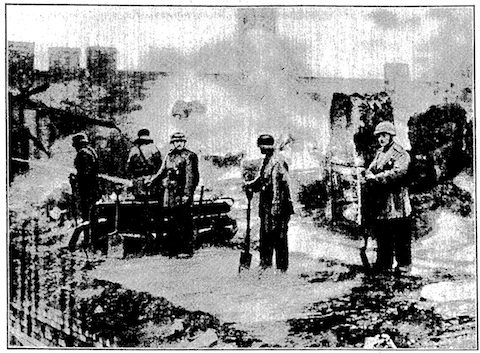
The Times gives the photos this caption (6):
DAMAGE IN BERLIN. — Two pictures just received from New York showing damaged caused by R.A.F. bombers in Berlin during a recent raid. Firemen are seen standing amid the ruins of a wrecked building and (right) [below!] gutted Berlin business premises. In spite of German claims that we have bombed residential areas, these are the only types of picture they are releasing.
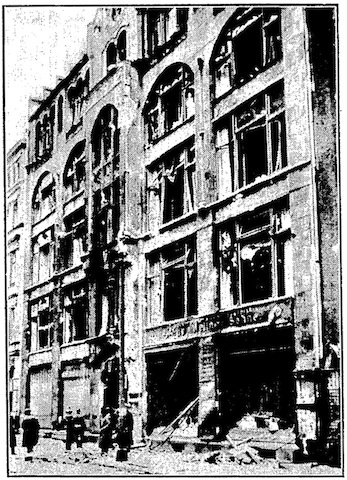
The Mail puts a slightly different spin on its caption to the above photo, which is on the front page:
BERLIN’S TURN
PICTURE which recalls the famous shot of bombed Regent-street (published in The Daily Mail last week). It was taken in a fashionable street of Berlin after one of the R.A.F. raids, and received here yesterday.
So The Times seems to distance the results of RAF bombing from those of the Luftwaffe, whereas the Daily Mail makes them sound more comparable. The latter is interesting when you compare it with the report of the latest raids on London, on the same page, which begins:
ONCE more last evening the German night raiders arrived over London for their customary bombing of civilians.
This does seem consistent with yesterday’s editorial arguing for the Germans to be given a taste of their own medicine.
In other news, the Luftwaffe launched daylight attacks yesterday, aiming (but failing) to reach London. Places attacked include ‘the Southampton area, Brighton, and towns along the Thames estuary’ (Manchester Guardian, 5). Eight German aircraft were shot down; they are said to have been using ‘Tip-and-Run Tactics’.
In an interview with a special correspondent of the Guardian (4), David Lloyd George has called for the ‘provision of adequate, comfortable, and well-equipped shelters deep underground’.
My daughter raised the issue in the House of Commons fully eighteen months ago when she and other members urged the construction of deep shelters. That was before the war, and particular mention was made of the need for adequate protection for the people in the East End of London, because their houses are so fragile and so many jerry-built, and because so many are without cellars and basements. The answer given then was that everything was being done or going to be done. They ought to have been provided.
The former premier alleges that there has been ‘an appalling lack of foresight, drive, and imagination in our plans for protecting our people and our industries against the inevitable perils of an unparalleled attack from the air’.
So what is the government doing? A new evacuation scheme has been announced: mothers and children from ‘certain of the hard-pressed London areas’ are now being ‘invited’ to evacuate to reception areas, even if they have not been made homeless by bombing (5).
The number of killed and wounded in the raids is far fewer than had been expected, but the Ministry [of Health] has come to the conclusion that if so many people from these hard-pressed areas are to spend most of their time in overcrowded shelters there will be real risk of the spread of infection. That, quite as much as the risk of injury or death from bombs, is what is prompting this new departure by the Ministry.
Whether this evacuation scheme will be more successful than the previous ones remains to be seen.
Everyone is puzzled over the Free French withdrawal from Dakar — de Gaulle’s statement that he did not want to shed French blood to overcome Vichy resistance doesn’t seem to satisfy many. In apparent retaliation for the (whatever it was), Gibraltar was bombed by ‘twenty or more ‘planes “of French types”‘. Four people were killed, twelve wounded, buildings and roads damaged. The Vichy government had threatened reprisals for Dakar, but de Gaulle recently claimed that some French aircraft in Morocco had been handed over to the Germans and/or Italians, so it could have been those.
![]() This work is licensed under a Creative Commons Attribution-NonCommercial-NoDerivatives 4.0 International License.
Permissions beyond the scope of this license may be available at http://airminded.org/copyright/.
This work is licensed under a Creative Commons Attribution-NonCommercial-NoDerivatives 4.0 International License.
Permissions beyond the scope of this license may be available at http://airminded.org/copyright/.




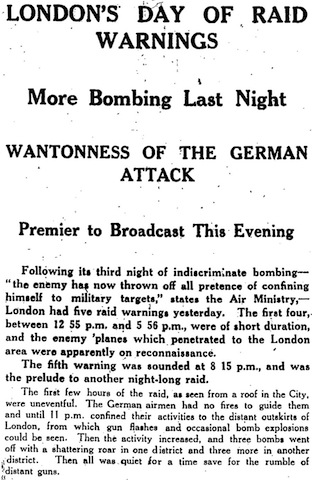
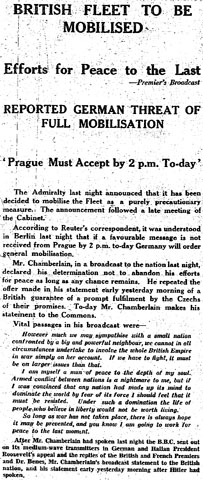
Interesting pictures from Germany. The first one could be anywhere or anything, but the second could hardly be taken for an ‘infrastructure/industrial,’ and still less a ‘military’ target.
So the Daily Mail may have been licking its lips, but The Times was non-committal. It would be interesting to know what the Guardian or New Statesman had to say about them. If anything. Did attitudes become steadily more polarised and extreme, and less ‘civilized,’ as the war went on? Did the Guardian continue to beat its breast about the horrors of war, or choose to look the other way in blushing silence?
Pingback: Airminded · Thursday, 26 September 1940
The Guardian didn’t comment on these photos, as far as I know. And it seems to be looking the other way, as you’ll see from the next post…
My understanding is that later in the war the debate became both more muted and more polarised — I’d guess that people became fixed in their opinions, and after the end of the Blitz ‘reprisals’ presumably became a less pressing concern after ‘military utility’. There were occasional flareups as with the Bombing Restriction Committee and Vera Brittain’s Seeds of Chaos. Mark Connelly has some interesting stuff on the debate in his Reaching for the Stars but there’s room for more research!
And now that I think of it, I wonder if reprisal calls resurfaced during the Baedeker raids and the Baby Blitz, not to mention during the V-weapon raids. I might look into that after the post-blogs are done.
Pingback: Airminded · Tuesday, 1 October 1940
Pingback: Airminded · The R word